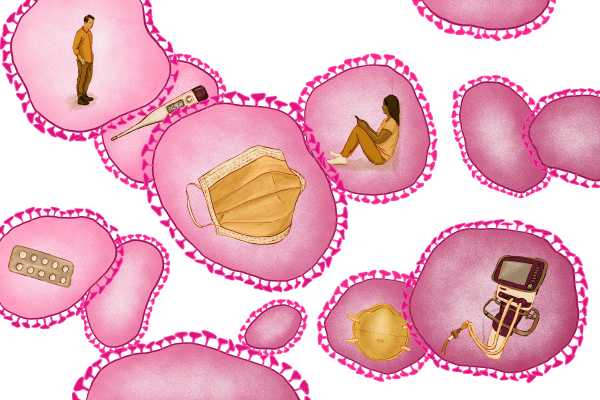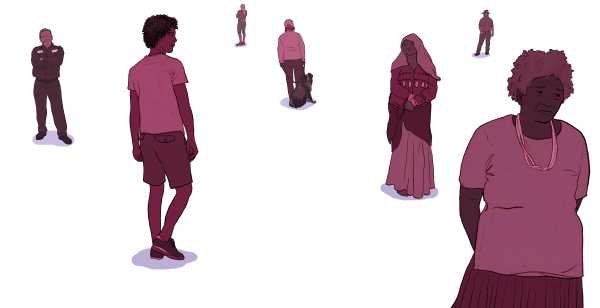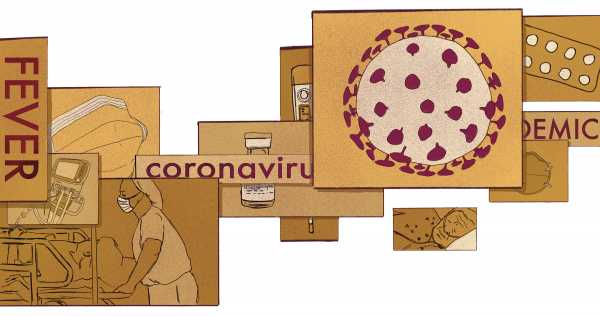
Ventilator vs. respirator, quarantine vs. isolation: Covid-19 pandemic terms, defined
A coronavirus pandemic glossary.
By
Brian Resnick@B_resnick
Updated
Mar 28, 2020, 10:30am EDT
Illustrations by Michelle Kondrich for Vox
Share this story
-
Share this on Facebook
-
Share this on Twitter
-
Share
All sharing options
Share
All sharing options for:
Ventilator vs. respirator, quarantine vs. isolation: Covid-19 pandemic terms, defined
-
Reddit
-
Pocket
-
Flipboard
-
Email
With the Covid-19 pandemic, there are so many new things we need to grow accustomed to. We’re physically avoiding many of the people and places we love, and too many are now being burdened by the sudden economic crisis that has arisen alongside the pandemic.
But there are also a lot of new, and confusing, terms we’re hearing about.
It’s okay if you’re unsure of the difference between a respirator and a ventilator, or the distinction between isolation and quarantine. We hope this glossary of pandemic terms will help.
We’ll update this as new confusing terms start popping up in the news.

Virus and outbreak terms
SARS-CoV-2 — The formal, scientific name of the virus that’s causing this pandemic. (It’s short for “severe acute respiratory syndrome coronavirus 2.”)
Covid-19 — The disease caused by the virus SARS-CoV-2. If you’re sick, you have Covid-19. You were infected by SARS-CoV-2. (If you’re still confused, think about how the HIV virus causes AIDS.)
Coronavirus — This is a family of viruses that SARS-CoV-2 belongs to (technically they are known as betacoronaviruses, but you can just say coronavirus). The 2003 SARS outbreak was a coronavirus, as was MERS in 2012. They are named coronaviruses because of their shape. When viewed through a microscope, the individual virus looks like a sphere surrounded by a spiky crown (or corona).
Endemic — A disease that regularly infects humans, like the flu, strep throat, or any common illness. There are four coronavirus strains that commonly infect humans, usually manifesting as colds. It’s possible that SARS-CoV-2 becomes endemic, too.
Pandemic — A worldwide spread of a new disease. Most famous, perhaps, is the 1918 flu pandemic that is believed to have infected one in three people on the planet. Pandemic diseases can become endemic. The World Health Organization declared Covid-19 a pandemic on March 11, 2020.
Epidemic — A disease that’s spreading over a wide area. An epidemic is a less severe designation than a pandemic, but there is an overlap between the two terms. And yes, it’s a bit confusing: “While a pandemic may be characterized as a type of epidemic, you would not say that an epidemic is a type of pandemic,” Merriam-Webster explains. The 2015-2016 spread of the Zika virus through South and Central America and the Caribbean was an epidemic.
Herd immunity — Herd immunity occurs when enough people become immune to a disease — either through exposure or via a vaccine — that the spread of the disease begins to slow, or stop, within a population. Right now, immunity to Covid-19 is not well understood. In time, researchers will be able to test the blood of people who have recovered from Covid-19 in the weeks and months following their infection and see if they still are immune. And those studies will teach us about whether we, collectively, can develop herd immunity to Covid-19.
Zoonotic disease — A illness that can pass between animals and humans. Covid-19 is a zoonotic disease. It’s believed SARS-CoV-2 comes from bats. HIV, Ebola, Zika virus, and even measles (which jumped from cows to humans a very long time ago) are all believed to have originated in animals, in some form, before spreading to humans.
R0 — Pronounced r-nought, R0 is the statistic that describes how contagious a disease is. “The figure refers to how many other people one sick person is likely to infect on average in a group that’s susceptible to the disease (meaning they don’t already have immunity from a vaccine or from fighting off the disease before),” Vox’s Julia Belluz explains. An R0 of 2, for example, means each infected person is expected to spread the virus to two others. The exact R0 for Covid-19 is still being determined, but it’s currently believed to be between 2 and 2.5.
Confirmed cases — The number of Covid-19 cases that have been confirmed by diagnostic testing. Due to a shortage of tests, the actual number of cases that exist is likely much higher.
Case fatality rate (CFR) — The death rate. This figure explains what percentage of Covid-19 cases are fatal. It varies by country and age group, and the final figure will depend on figuring out the true number of cases (which is hard to estimate without widespread testing).
Modes of transmission — How a virus spreads from one person to another. Scientists are still working out how exactly this virus spreads. The main mode of transmission appears to be via droplets. These are bits of virus-laden fluid a person spews out when they cough or sneeze. Researchers are still working out the conditions under which the virus can be airborne, meaning how long viral particles can linger in the air under some environmental conditions. It’s also possible that the virus can spread via the fecal-oral route, meaning the virus can be transmitted through feces, which can then contaminate water or food if good hygiene is lacking.

Public health measures
Social distancing — A slew of tactics meant to keep people from congregating, with the goal of keeping people 6 feet apart from one another. Six feet of distance helps keep droplets from an infected person’s nose or mouth from hitting another person. These tactics include canceling schools, public events, closing down restaurants, and banning events of 10 or more people.
Quarantine — Restricting the movement of, or isolating, people who might have been exposed to an infection but who aren’t yet sick. Usually, quarantine restricts a person’s movement to their home.
Isolation — Separating people with confirmed or probable infections from other healthy people, so that they can get better without infecting anyone else. One member of a household could be in isolation (perhaps in a designated room that others do not enter), while the other members of the household are in quarantine (free to move around the home but not enter the isolation area).
Lockdown — “The term ‘lock-down’ isn’t a technical term used by public health officials or lawyers,” Lindsay Wiley, a health law professor at the Washington College of Law, explained in an email. “It could be used to refer to anything from mandatory geographic quarantine (which would probably be unconstitutional under most scenarios in the US), to non-mandatory recommendations to shelter in place (which are totally legal and can be issued by health officials at the federal, state, or local level), to anything in between (e.g. ordering certain events or types of businesses to close, which is generally constitutional if deemed necessary to stop the spread of disease based on available evidence).”
Cordon sanitaire — The restriction of movement in and out of a region or city. China imposed one on the city of Wuhan during the early days of the outbreak.
Shelter in place — An order requesting people stay at home, except for trips to the grocery store, pharmacies, and other essential errands. Each state or city might define “shelter in place” slightly differently. (Like “lockdown,” this term can refer to a variety of guidelines.) Each local government could also enforce these orders differently — from just asking citizens to do it on a volunteer basis to enforcing orders with police citations. The important thing is to check with your local authority for details on what is allowed, and what is not, when the local government tells you to shelter in place. Some cities, like Washington, DC, are not using this term but are instead telling people to “stay home.” It’s effectively the same thing.

Medical equipment and pharmaceuticals
Ventilator — A machine that moves air in and out of the lungs in the case that a patient cannot, or is having trouble breathing on their own.
PPE — Personal protective equipment, such as masks, gloves, face shields, and other gear that keeps health care workers from catching an infection.
Respirator — A face mask that seals around the mouth and filters out particles from the air before they are breathed in. An N95 respirator, for example, filters out “95 percent of very small (0.3 micron) test particles,” the Food and Drug Administration explains. Doctors, nurses, and hospital workers are facing shortages of this essential protective facewear.
Surgical mask or face mask — These are loose-fitting masks that don’t filter out as many particles as a respirator. But they do stop a wearer from spreading droplets of contagion when they sneeze or cough. They’re also helpful in preventing a wearer from touching their face with dirty hands.
Chloroquine or hydroxychloroquine — Antimalarial drugs hyped by President Trump (despite weak evidence) as being potentially useful in treating Covid-19. Clinical trials of these drugs are underway, but early evidence is still not clear they prove useful. These aren’t the only drugs currently being tested to treat Covid-19: Doctors are also testing antiviral medication and some HIV drugs. These drugs are also used to treat arthritis and lupus, as they also have anti-inflammatory properties.
Fever — Generally, a fever is when the body temperature exceeds 100.4°F, according to the Centers for Disease Control and Prevention (CDC). But there is some variability here. Human bodies tend to be coldest when we wake up. So a 100.4-degree fever in the morning might grow a little hotter throughout the day. Some people also run a little hotter or colder than others. The CDC advises “fever may be considered to be present if a person has not had a temperature measurement but feels warm to the touch, or gives a history of feeling feverish.”
Pneumonia — When the small air sacs of the lungs (alveoli, the structures where gases from the atmosphere are exchanged with the blood) become inflamed and fill up with fluid. It’s a possible symptom of Covid-19.
Reverse transcription polymerase chain reaction (RT-PCR) — A technology used for Covid-19 diagnostic testing. It looks for the virus’s genetic signature.
Serological tests — A diagnostic test that looks for antibodies (a blood protein built to help fight off a specific virus or pathogen), could tell if someone has ever been infected with Covid-19, and could suggest they are possibly immune. These tests are still being developed for Covid-19.
Vaccine — A formulation to stimulate the immune system to produce antibodies for a pathogen in the hope of providing immunity to that pathogen. Vaccines for SARS-CoV-2 are being tested, but it could be a year or more before they are approved. A safe and effective vaccine can stop this pandemic in its tracks.
Therapeutics — Drugs that lessen the severity of disease symptoms. The World Health Organization is currently facilitating a multinational clinical trial, testing medicines — and combinations of medicines — to treat Covid-19. Therapeutics won’t necessarily stop the outbreak, though. They may keep people from getting severely sick or dying. Even with therapeutics, the virus could still spread, infecting millions.
Sourse: vox.com





